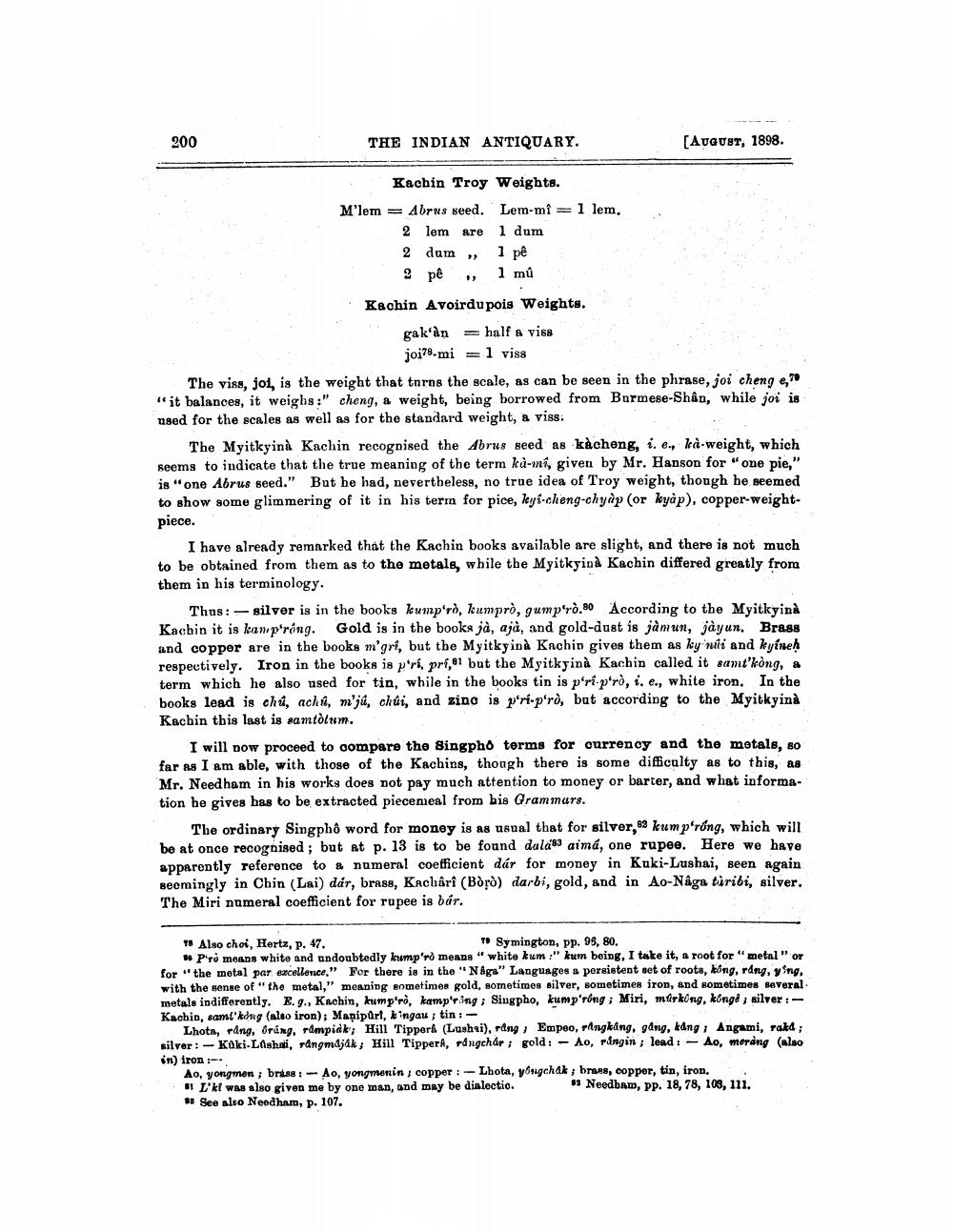________________
200
THE INDIAN ANTIQUARY.
[Avqust, 1898.
Kachin Troy Weights. M'lem = Abrus seed. Lem-mi=1 lem.
2 lem are 1 dum 2 dum l pe
2 pel mû Kachin Avoirdu pois Weights.
gak'àn = half a viss
joi78.mi = l viss The viss, joi, is the weight that turns the scale, as can be seen in the phrase, joi cheng e, 70 "it balances, it weighs :" cheng, a weight, being borrowed from Burmese-Shân, while joi is used for the scales as well as for the standard weight, a vissi
The Myitkyina Kachin recognised the Abrus seed as kàcheng, i.e., ka-weight, which seems to indicate that the true meaning of the term ků-mí, given by Mr. Hanson for "one pie," is one Abrus seed." But he had, nevertheless, no true idea of Troy weight, though he seemed to show some glimmering of it in his term for pice, kyl-cheng-chyay (or kyàp), copper-weightpiece.
I have already remarked that the Kachin books available are slight, and there is not much to be obtained from them as to the metals, while the Myitkyina Kachin differed greatly from them in his terminology.
Thus: - silver is in the books kump'rò, kumprò, gump'rò.80 According to the Myitkyina Kachin it is kanıp'rông. Gold is in the books jà, ajà, and gold-dust is jamun, jàyun. Brass and copper are in the books m'gri, but the Myitkyina Kachin gives them as kyni and kyineh respectively. Iron in the books is pri prí,e1 but the Myitkyina Kachin called it samt'kòng, a term which he also used for tin, while in the books tin is pri ptrò, i, e., white iron. In the books lead is chri, acha, m'jú, chúi, and zing is pri-pirò, but according to the Myitkyina Kachin tbis last is samtotum.
I will now proceed to compare the singpho terms for currency and the metals, so far as I am able, with those of the Kachins, though there is some difficulty as to this, as Mr. Needham in his works does not pay much attention to money or barter, and what information he gives has to be extracted piecemeal from bis Grammars.
The ordinary Singphô word for money is as usual that for silver, kump'rống, which will be at once recognised; but at p. 13 is to be found dula83 aimá, one rupee. Here we have apparently reference to a numeral coefficient dár for money in Kuki-Lushai, seen again seemingly in Chin (Lai) dár, brass, Kachâri (Bòrò) darbi, gold, and in Ao Någa tiribi, silver. The Miri numeral coefficient for rupee is bár.
* Also choi, Hertz, p. 47.
TSymington, pp. 95, 80. # Prů means white and undoubtedly kump'rd means " white kum" kum being, I take it, a root for "metal" or for the metal par excellence." For there is in the "Någa" Languages a persistent set of roots, bóng, rang, yang with the sense of "the metal," meaning sometimer gold, sometimes silver, sometimes iron, and sometimes several metals indifferently. E.9., Kachin, kump'ro, kamp'ring; Singpho, kump'ring; Miri, murkóng, kingi, silver :Kachin, saml'kong (also iron); Manipurl, kingau; tin: -
Lhota, ring, Oring, rampiek; Hill Tippera (Lushui), rang Empeo, singkang, gang, kang; Angami, rakd ; silver: - Koki-LOshadi, rangmdjak, Hill Tipper, rangchár ; gold - Ao, ringin lead - Ao, morang (also in) iron :
Ao, yongmen; brass - Ao, yongmenin copper: - Lhota, yngchak, brass, copper, tin, iron, "L'kt was also given me by one man, and may be dialectio. " Needbam, pp. 18, 78, 109, 111. * See also Needham, p. 107.




